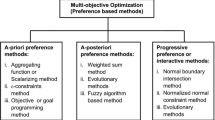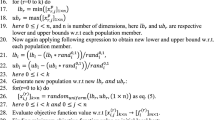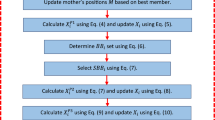Abstract
Generalized normal distribution optimization (GNDO) inspired by the theory of normal distribution is a recently developed metaheuristic method for global optimization problems. This work presents a novel variant of GNDO, which is called elite-driven generalized normal distribution optimization (EDGNDO). EDGNDO enhances the global search ability of GNDO by the designed search mechanism consisting of three local search operators and three global search operators that are based on two built archives used to save elite individuals. Note that, EDGNDO only needs population size and termination criteria for optimization, which can distinguish it over the most reported metaheuristic methods. The performance of EDGNDO is investigated by the well-known CEC 2017 test suite including three unimodal functions and 27 multimodal functions. Experimental results demenstrate that EDGNDO is obviously better than GNDO and the other five powerful algorithms in terms of solution quality and computational efficiency. In addition, EDGNDO is also used for solving four challenging constrained engineering design problems. Experimental results support the superiority of EDGNDO in solving the four problems. The superiority of EDGNDO in solving complex optimization problems is proven. The source code can be loaded from https://github.com/jsuzyy/EDGNDO.














Similar content being viewed by others
References
Abd Elaziz M, Attiya I (2021) An improved Henry gas solubility optimization algorithm for task scheduling in cloud computing. Artif Intell Rev 54:3599–3637. https://doi.org/10.1007/s10462-020-09933-3
Abdel-Basset M, Ding W, El-Shahat D (2021) A hybrid Harris Hawks optimization algorithm with simulated annealing for feature selection. Artif Intell Rev 54:593–637. https://doi.org/10.1007/s10462-020-09860-3
Abdel-Basset M, El-Shahat D, Sangaiah AK (2019) A modified nature inspired meta-heuristic whale optimization algorithm for solving 0–1 knapsack problem. Int J Mach Learn Cybern 10:495–514. https://doi.org/10.1007/s13042-017-0731-3
Abualigah L, Diabat A (2021) Advances in sine cosine algorithm: a comprehensive survey. Artif Intell Rev 54:2567–2608. https://doi.org/10.1007/s10462-020-09909-3
Abualigah L, Diabat A, Mirjalili S et al (2021a) The arithmetic optimization algorithm. Comput Methods Appl Mech Eng 376:113609. https://doi.org/10.1016/j.cma.2020.113609
Abualigah L, Yousri D, Abd Elaziz M et al (2021b) Aquila Optimizer: A novel meta-heuristic optimization algorithm. Comput Ind Eng 157:107250. https://doi.org/10.1016/j.cie.2021.107250
Anand P, Arora S (2020) A novel chaotic selfish herd optimizer for global optimization and feature selection. Artif Intell Rev 53:1441–1486. https://doi.org/10.1007/s10462-019-09707-6
Askarzadeh A (2016) A novel metaheuristic method for solving constrained engineering optimization problems: Crow search algorithm. Comput Struct 169:1–12. https://doi.org/10.1016/j.compstruc.2016.03.001
Azizi M (2021) Atomic orbital search: A novel metaheuristic algorithm. Appl Math Model 93:657–683. https://doi.org/10.1016/j.apm.2020.12.021
Baadji B, Bentarzi H, Bakdi A (2020) Comprehensive learning bat algorithm for optimal coordinated tuning of power system stabilizers and static VAR compensator in power systems. Eng Optim 52:1761–1779. https://doi.org/10.1080/0305215X.2019.1677635
Baykasoğlu A, Akpinar Ş (2015) Weighted Superposition Attraction (WSA): A swarm intelligence algorithm for optimization problems – Part 2: Constrained optimization. Appl Soft Comput 37:396–415. https://doi.org/10.1016/j.asoc.2015.08.052
Caldeira RH, Gnanavelbabu A (2021) A Pareto based discrete Jaya algorithm for multi-objective flexible job shop scheduling problem. Expert Syst Appl 170:114567. https://doi.org/10.1016/j.eswa.2021.114567
Czerniak JM, Zarzycki H, Ewald D (2017) AAO as a new strategy in modeling and simulation of constructional problems optimization. High-Perform Model Simul Big Data Appl 76:22–33. https://doi.org/10.1016/j.simpat.2017.04.001
Dhiman G, Kumar V (2017) Spotted hyena optimizer: A novel bio-inspired based metaheuristic technique for engineering applications. Adv Eng Softw 114:48–70. https://doi.org/10.1016/j.advengsoft.2017.05.014
Du T-S, Ke X-T, Liao J-G, Shen Y-J (2018) DSLC-FOA : Improved fruit fly optimization algorithm for application to structural engineering design optimization problems. Appl Math Model 55:314–339. https://doi.org/10.1016/j.apm.2017.08.013
Gabis AB, Meraihi Y, Mirjalili S, Ramdane-Cherif A (2021) A comprehensive survey of sine cosine algorithm: variants and applications. Artif Intell Rev 54:5469–5540. https://doi.org/10.1007/s10462-021-10026-y
Gandomi AH, Yang X-S, Alavi AH (2011) Mixed variable structural optimization using Firefly Algorithm. Comput Struct 89:2325–2336. https://doi.org/10.1016/j.compstruc.2011.08.002
Guo W, Wang Y, Dai F, Xu P (2020) Improved sine cosine algorithm combined with optimal neighborhood and quadratic interpolation strategy. Eng Appl Artif Intell 94:103779. https://doi.org/10.1016/j.engappai.2020.103779
Hashim FA, Houssein EH, Mabrouk MS et al (2019) Henry gas solubility optimization: A novel physics-based algorithm. Future Gener Comput Syst 101:646–667. https://doi.org/10.1016/j.future.2019.07.015
Hatta NM, Zain AM, Sallehuddin R et al (2019) Recent studies on optimisation method of Grey Wolf Optimiser (GWO): a review (2014–2017). Artif Intell Rev 52:2651–2683. https://doi.org/10.1007/s10462-018-9634-2
Heidari AA, Mirjalili S, Faris H et al (2019) Harris hawks optimization: Algorithm and applications. Future Gener Comput Syst 97:849–872. https://doi.org/10.1016/j.future.2019.02.028
Houssein EH, Hussain K, Abualigah L et al (2021) An improved opposition-based marine predators algorithm for global optimization and multilevel thresholding image segmentation. Knowl-Based Syst 229:107348. https://doi.org/10.1016/j.knosys.2021.107348
Houssein EH, Saad MR, Hashim FA et al (2020) Lévy flight distribution: A new metaheuristic algorithm for solving engineering optimization problems. Eng Appl Artif Intell 94:103731. https://doi.org/10.1016/j.engappai.2020.103731
Hussien AG, Amin M (2021) A self-adaptive Harris Hawks optimization algorithm with opposition-based learning and chaotic local search strategy for global optimization and feature selection. Int J Mach Learn Cybern. https://doi.org/10.1007/s13042-021-01326-4
Kaveh A, Dadras A (2017) A novel meta-heuristic optimization algorithm: Thermal exchange optimization. Adv Eng Softw 110:69–84. https://doi.org/10.1016/j.advengsoft.2017.03.014
Kaveh A, Khayatazad M (2012) A new meta-heuristic method: Ray Optimization. Comput Struct 112–113:283–294. https://doi.org/10.1016/j.compstruc.2012.09.003
Kaveh A, Mahdavi VR (2014) Colliding bodies optimization: A novel meta-heuristic method. Comput Struct 139:18–27. https://doi.org/10.1016/j.compstruc.2014.04.005
Kennedy J, Eberhart R (1995) Particle swarm optimization. In: Proceedings of ICNN’95-International Conference on Neural Networks. IEEE, pp 1942–1948
Koziel S, Pietrenko-Dabrowska A (2021) Global EM-driven optimization of multi-band antennas using knowledge-based inverse response-feature surrogates. Knowl-Based Syst 227:107189. https://doi.org/10.1016/j.knosys.2021.107189
Kumari K, Singh JP, Dwivedi YK, Rana NP (2021) Multi-modal aggression identification using convolutional neural network and binary particle swarm optimization. Future Gener Comput Syst 118:187–197. https://doi.org/10.1016/j.future.2021.01.014
Laha D, Gupta JND (2018) An improved cuckoo search algorithm for scheduling jobs on identical parallel machines. Comput Ind Eng 126:348–360. https://doi.org/10.1016/j.cie.2018.09.016
Li S, Chen H, Wang M et al (2020) Slime mould algorithm: A new method for stochastic optimization. Future Gener Comput Syst 111:300–323. https://doi.org/10.1016/j.future.2020.03.055
Li Y, Wang S (2020) Differential evolution algorithm with elite archive and mutation strategies collaboration. Artif Intell Rev 53:4005–4050. https://doi.org/10.1007/s10462-019-09786-5
Lin JT, Chiu C-C (2018) A hybrid particle swarm optimization with local search for stochastic resource allocation problem. J Intell Manuf 29:481–495. https://doi.org/10.1007/s10845-015-1124-7
Meng Z, Pan J-S (2016) Monkey King Evolution: A new memetic evolutionary algorithm and its application in vehicle fuel consumption optimization. Knowl-Based Syst 97:144–157. https://doi.org/10.1016/j.knosys.2016.01.009
Meraihi Y, Gabis AB, Ramdane-Cherif A, Acheli D (2021) A comprehensive survey of crow search algorithm and its applications. Artif Intell Rev 54:2669–2716. https://doi.org/10.1007/s10462-020-09911-9
Mirjalili S (2016) SCA: A sine cosine algorithm for solving optimization problems. Knowl-Based Syst 96:120–133. https://doi.org/10.1016/j.knosys.2015.12.022
Mirjalili S (2015) Moth-flame optimization algorithm: A novel nature-inspired heuristic paradigm. Knowl-Based Syst 89:228–249. https://doi.org/10.1016/j.knosys.2015.07.006
Mirjalili S, Gandomi AH, Mirjalili SZ et al (2017) Salp Swarm Algorithm: A bio-inspired optimizer for engineering design problems. Adv Eng Softw 114:163–191. https://doi.org/10.1016/j.advengsoft.2017.07.002
Mirjalili S, Lewis A (2016) The Whale Optimization Algorithm. Adv Eng Softw 95:51–67. https://doi.org/10.1016/j.advengsoft.2016.01.008
Mirjalili S, Mirjalili SM, Lewis A (2014) Grey Wolf Optimizer Adv Eng Softw 69:46–61. https://doi.org/10.1016/j.advengsoft.2013.12.007
Mousavi SM, Alikar N, Tavana M, Di Caprio D (2019) An improved particle swarm optimization model for solving homogeneous discounted series-parallel redundancy allocation problems. J Intell Manuf 30:1175–1194. https://doi.org/10.1007/s10845-017-1311-9
Nouiri M, Bekrar A, Jemai A et al (2018) An effective and distributed particle swarm optimization algorithm for flexible job-shop scheduling problem. J Intell Manuf 29:603–615. https://doi.org/10.1007/s10845-015-1039-3
Parouha RP, Verma P (2021) An innovative hybrid algorithm for bound-unconstrained optimization problems and applications. J Intell Manuf. https://doi.org/10.1007/s10845-020-01691-x
Peng H, Zeng Z, Deng C, Wu Z (2021) Multi-strategy serial cuckoo search algorithm for global optimization. Knowl-Based Syst 214:106729. https://doi.org/10.1016/j.knosys.2020.106729
Pietrenko-Dabrowska A, Koziel S (2021) Globalized parametric optimization of microwave components by means of response features and inverse metamodels. Sci Rep 11:23718. https://doi.org/10.1038/s41598-021-03095-0
Qais MH, Hasanien HM, Alghuwainem S (2020) Transient search optimization: a new meta-heuristic optimization algorithm. Appl Intell 50:3926–3941. https://doi.org/10.1007/s10489-020-01727-y
Rahaman J, Sing M (2021) An efficient multilevel thresholding based satellite image segmentation approach using a new adaptive cuckoo search algorithm. Expert Syst Appl 174:114633. https://doi.org/10.1016/j.eswa.2021.114633
Rakhshani H, Rahati A (2017) Snap-drift cuckoo search: A novel cuckoo search optimization algorithm. Appl Soft Comput 52:771–794. https://doi.org/10.1016/j.asoc.2016.09.048
Sadollah A, Sayyaadi H, Yadav A (2018) A dynamic metaheuristic optimization model inspired by biological nervous systems: Neural network algorithm. Appl Soft Comput 71:747–782. https://doi.org/10.1016/j.asoc.2018.07.039
Salgotra R, Singh U, Saha S (2018) New cuckoo search algorithms with enhanced exploration and exploitation properties. Expert Syst Appl 95:384–420. https://doi.org/10.1016/j.eswa.2017.11.044
Savsani P, Savsani V (2016) Passing vehicle search (PVS): A novel metaheuristic algorithm. Appl Math Model 40:3951–3978. https://doi.org/10.1016/j.apm.2015.10.040
Souravlias D, Parsopoulos KE (2016) Particle swarm optimization with neighborhood-based budget allocation. Int J Mach Learn Cybern 7:451–477. https://doi.org/10.1007/s13042-014-0308-3
Storn R, Price K (1997) Differential Evolution – A Simple and Efficient Heuristic for global Optimization over Continuous Spaces. J Glob Optim 11:341–359. https://doi.org/10.1023/A:1008202821328
Su B, Xie N, Yang Y (2021) Hybrid genetic algorithm based on bin packing strategy for the unrelated parallel workgroup scheduling problem. J Intell Manuf 32:957–969. https://doi.org/10.1007/s10845-020-01597-8
Talatahari S, Azizi M (2021) Chaos Game Optimization: a novel metaheuristic algorithm. Artif Intell Rev 54:917–1004. https://doi.org/10.1007/s10462-020-09867-w
Tilahun SL, Ngnotchouye JMT, Hamadneh NN (2019) Continuous versions of firefly algorithm: a review. Artif Intell Rev 51:445–492. https://doi.org/10.1007/s10462-017-9568-0
Tomasson JA, Koziel S, Pietrenko-Dabrowska A (2020) Quasi-Global Optimization of Antenna Structures Using Principal Components and Affine Subspace-Spanned Surrogates. IEEE Access 8:50078–50084. https://doi.org/10.1109/ACCESS.2020.2980057
Wang C, Liu Y, Zhao Y (2013) Application of dynamic neighborhood small population particle swarm optimization for reconfiguration of shipboard power system. Eng Appl Artif Intell 26:1255–1262. https://doi.org/10.1016/j.engappai.2012.12.010
Wang J, Zhou B (2016) A hybrid adaptive cuckoo search optimization algorithm for the problem of chaotic systems parameter estimation. Neural Comput Appl 27:1511–1517. https://doi.org/10.1007/s00521-015-1949-1
Wang Y, Liu Z-Z, Li J et al (2016) Utilizing cumulative population distribution information in differential evolution. Appl Soft Comput 48:329–346. https://doi.org/10.1016/j.asoc.2016.07.012
Wu G, Mallipeddi R, Suganthan P (2017) Problem definitions and evaluation criteria for the CEC 2017 competition on constrained real-parameter optimization. Natl Univ Def Technol Chang Hunan PR China Kyungpook Natl Univ Daegu South Korea Nanyang Technol Univ Singap Tech Rep
Xu B, Cheng W, Qian F, Huang X (2019) Self-adaptive differential evolution with multiple strategies for dynamic optimization of chemical processes. Neural Comput Appl 31:2041–2061. https://doi.org/10.1007/s00521-018-03985-x
Yang X, Deb S (2009) Cuckoo Search via Lévy flights. In: 2009 World Congress on Nature Biologically Inspired Computing (NaBIC). pp 210–214
Xin-She Y, Amir HG (2012) Bat algorithm: a novel approach for global engineering optimization. Eng Comput 29:464–483. https://doi.org/10.1108/02644401211235834
Yang X-S, Deb S (2014) Cuckoo search: recent advances and applications. Neural Comput Appl 24:169–174. https://doi.org/10.1007/s00521-013-1367-1
Yang Y, Chen H, Li S et al (2020) Orthogonal learning harmonizing mutation-based fruit fly-inspired optimizers. Appl Math Model 86:368–383. https://doi.org/10.1016/j.apm.2020.05.019
Yi J, Li X, Chu C-H, Gao L (2019) Parallel chaotic local search enhanced harmony search algorithm for engineering design optimization. J Intell Manuf 30:405–428. https://doi.org/10.1007/s10845-016-1255-5
Yu K, Liang JJ, Qu BY et al (2018) Multiple learning backtracking search algorithm for estimating parameters of photovoltaic models. Appl Energy 226:408–422. https://doi.org/10.1016/j.apenergy.2018.06.010
Zeng N, Wang Z, Liu W et al (2020) A Dynamic Neighborhood-Based Switching Particle Swarm Optimization Algorithm. IEEE Trans Cybern. https://doi.org/10.1109/TCYB.2020.3029748
Zhang X, Lin Q (2022) Three-learning strategy particle swarm algorithm for global optimization problems. Inf Sci 593:289–313. https://doi.org/10.1016/j.ins.2022.01.075
Zhang Y, Jin Z (2021) Comprehensive learning Jaya algorithm for engineering design optimization problems. J Intell Manuf. https://doi.org/10.1007/s10845-020-01723-6
Zhang Y, Jin Z, Mirjalili S (2020) Generalized normal distribution optimization and its applications in parameter extraction of photovoltaic models. Energy Convers Manag 224:113301. https://doi.org/10.1016/j.enconman.2020.113301
Acknowledgements
This work is supported by the Research Foundation for Talented Scholars of Jiangsu University, China (Grand No. 21JDG065).
Author information
Authors and Affiliations
Corresponding author
Ethics declarations
Conflict of interest
The authors declare that they have no conflict of interest.
Additional information
Publisher's Note
Springer Nature remains neutral with regard to jurisdictional claims in published maps and institutional affiliations.
Appendices
Appendix A
See Tables
20,
21,
22,
Appendix B
2.1 Mathematical expression of pressure vessel design problem
where \(\, 0 \le x_{i} \le 100, \, i = 1,2; \, 10 \le x_{i} \le 200, \, i = 3,4\).
2.2 Mathematical expression of welded beam design problem
2.3 Mathematical expression of speed reducer design problem
where \(2.6 \le x_{1} \le 3.6, \, 0.7 \le x_{2} \le 0.8,17 \le x_{3} \le 28,{ 7}{\text{.3}} \le x_{4} \le 8.3,{7}{\text{.3}} \le x_{5} \le 8.3,{ 2}{\text{.9}} \le x_{6} \le 3.9,{ 5}{\text{.0}} \le x_{7} \le 5.5\).
2.4 Mathematical expression of tension/compression design problem
where \(\, 0.05 \le x_{1} \le 2, \, 0.25 \le x_{2} \le 1.30, \, 2.00 \le x_{3} \le 15.00\).
Rights and permissions
About this article
Cite this article
Zhang, Y. An improved generalized normal distribution optimization and its applications in numerical problems and engineering design problems. Artif Intell Rev 56, 685–747 (2023). https://doi.org/10.1007/s10462-022-10182-9
Published:
Issue Date:
DOI: https://doi.org/10.1007/s10462-022-10182-9




